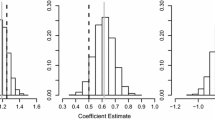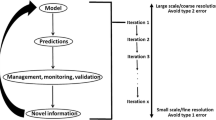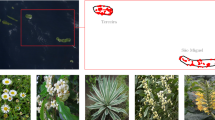Abstract
In this paper we develop a Bayesian approach to parameter estimation in a stochastic spatio-temporal model of the spread of invasive species across a landscape. To date, statistical techniques, such as logistic and autologistic regression, have outstripped stochastic spatio-temporal models in their ability to handle large numbers of covariates. Here we seek to address this problem by making use of a range of covariates describing the bio-geographical features of the landscape. Relative to regression techniques, stochastic spatio-temporal models are more transparent in their representation of biological processes. They also explicitly model temporal change, and therefore do not require the assumption that the species’ distribution (or other spatial pattern) has already reached equilibrium as is often the case with standard statistical approaches. In order to illustrate the use of such techniques we apply them to the analysis of data detailing the spread of an invasive plant, Heracleum mantegazzianum, across Britain in the 20th Century using geo-referenced covariate information describing local temperature, elevation and habitat type. The use of Markov chain Monte Carlo sampling within a Bayesian framework facilitates statistical assessments of differences in the suitability of different habitat classes for H. mantegazzianum, and enables predictions of future spread to account for parametric uncertainty and system variability. Our results show that ignoring such covariate information may lead to biased estimates of key processes and implausible predictions of future distributions.
Similar content being viewed by others
References
Beaumont, M.A., Zhang, W., Balding, D.J., 2002. Approximate Bayesian computation in population genetics. Genetics 162, 2025–2035.
Beerling, D.J., 1993. The impact of temperature on the northern distribution limits of the introduced species Fallopia japonica and Impatiens glandulifera in north-west Europe. J. Biogeogr. 20, 45–53.
Berger, J.O., 1985. Statistical Decision Theory and Bayesian Analysis, 2 edn. Springer, Berlin.
Besag, J., 1978. Some methods of statistical analysis for spatial data. Bull. Int. Stat. Inst. 47, 77–92.
Besag, J., 1986. On the statistical analysis of dirty pictures. J. Roy. Stat. Soc. B 48, 259–302.
Besag, J., Kooperberg, C., 1995. On conditional and intrinsic autoregressions. Biometrika 82, 733–746.
Buckland, S.T., Elston, D.A., 1993. Empirical models for the spatial distribution of wildlife. J. Appl. Ecol. 30, 478–495.
Caffrey, J.M., 2001. The management of Giant Hogweed in an Irish river catchment. J. Aquatic Plant Manag. 39, 28–33.
Campbell, G.S., Blackwell, P.G., Woodward, F.I., 2002. Can landscape-scale characteristics be used to predict plant invasions along rivers? J. Biogeogr. 29, 535–543.
Carlin, B.P., Louis, T.A., 2000. Bayes and Empirical Bayes Methods for Data Analysis, 2 edn. Chapman & Hall/CRC Press, London/Boca Raton.
Clapham, A.R., Tutin, T.G., Moore, D.M., 1985. Flora of the British Isles, 3 edn. Cambridge University Press, Cambridge.
Clark, J.S., 2005. Why environmental scientists are becoming Bayesians. Ecol. Lett. 8, 2–14.
Collingham, Y.C., Hill, M.O., Huntley, B., 1996. The migration of sessile organisms: a simulation model with measurable parameters. J. Veg. Sci. 7, 831–846.
Collingham, Y.C., Wadsworth, R.A., Huntley, B., Hulme, P.E., 2000. Predicting the spatial distribution of non-indigenous riparian weeds: issues of spatial scale and extent. J. Appl. Ecol. 37(Suppl. 1), 13–27.
Cook, A., 2006. Inference and prediction in plant populations using data augmentation within a Bayesian framework. Ph.D. thesis, Heriot-Watt University.
Cox, D.R., Isham, V., 1980. Point Processes. Monographs on Applied Probability and Statistics, vol. 12. Chapman & Hall, London.
Fewster, R.M., 2003. A spatiotemporal stochastic process model for species spread. Biometrics 59, 640–649.
Gamerman, D., 1997. Markov Chain Monte Carlo: Stochastic Simulation for Bayesian Inference, 1 edn. Chapman & Hall, London.
Gelfand, A.E., Schmidt, A.M., Wu, S., Silander, J.A.J., Latimer, A., Rebelo, A.G., 2005. Modelling species diversity through species level hierarchical modelling. J. Roy. Stat. Soc. C, 54, 1–20.
Geman, S., Bienenstock, E., Doursat, R., 1992. Neural networks and the bias/variance dilemma. Neural Comput. 4, 1–58.
Gibson, G.J., 1997. Investigating mechanisms of spatiotemporal epidemic spread using stochastic models. Phytopathology, 87, 139–146.
Gibson, G., Otten, W., Filipe, J., Cook, A., Marion, G., Gilligan, C., 2006. Bayesian estimation for percolation models of disease spread in plant communities. Stat. Comput. 16, 391–402.
Gilks, W.R., Richardson, S., Spiegelhalter, D.J., 1996. Introducing Markov Chain Monte Carlo. In Gilks, W.R., Richardson, S., Spiegelhalter, D.J. (Eds.), Markov Chain Monte Carlo in Practice, pp. 1–19. Chapman & Hall, London.
Hastings, A., Cuddington, K., Davies, K., Dugaw, C., Elmendorf, S., Freestone, A., Harrison, S., Holland, M., Lambrinos, J., Malvadkar, U., Melbourne, B., Moore, K., Taylor, C., Thomson, D., 2005. The spatial spread of invasions: new developments in theory and evidence. Ecol. Lett. 8, 91–101.
Heikkinen, J., Hogmander, H., 1994. Fully Bayesian approach to image restoration with application in biogeography. J. Roy. Stat. Soc. C, 43, 569–582.
Hierro, J.L., Maron, J.L., Callaway, R.M., 2005. A biogeographical approach to plant invasions: the importance of studying exotics in their introduced and native range. J. Ecol. 93, 5–15.
Hitchcock, C., Sober, E., 2004. Prediction versus accommodation and the risk of overfitting. Br. J. Philos. Sci. 55, 1–34.
Höhle, M., Jørgensen, E., O’Neill, P.D., 2005. Inference in disease transmission experiments by using stochastic epidemic models. Appl. Stat. 54, 349–366.
Huffer, F.W., Wu, H., 1998. Markov chain Monte Carlo for autologistic regression models with application to the distribution of plant species. Biometrics, 54, 509–524.
Kolar, C., Lodge, D., 2001. Progress in invasion biology: predicting invaders. Trends Ecol. Evol. 16, 199–204.
Lagey, K., Duinslaeger, L., Vanderkelen, A., 1995. Burns induced by plants. Burns, 21, 542–543.
Lee, P.M., 2004. Bayesian Statistics: An Introduction, 3rd edn. Arnold, London.
Mack, R.N., 1996. Predicting the identity and fate of plant invaders: emergent and emerging approaches. Biol. Conserv. 78, 107–121.
Manchester, S.J., Bullock, J.M., 2000. The impacts of non-native species on UK biodiversity and the effectiveness of control. J. Appl. Ecol. 37, 845–864.
Marion, G., Gibson, G.J., Renshaw, E., 2003. Estimating likelihoods for spatio-temporal models using importance sampling. Stat. Comput. 13, 111–119.
Marjoram, P., Molitor, J., Plagnol, V., Tavaré, S., 2003. Markov chain Monte Carlo without likelihoods. Proc. Nat. Acad. Sci. 100, 15324–15328.
Mollison, D., Isham, V., Grenfell, B., 1994. Epidemics: models and data. J. Roy. Stat. Soc. A 157, 115–149.
Ord, J.K., 1975. Estimation methods for models of spatial interaction. J. Am. Stat. Assoc. 70, 120–126.
Pritchard, J.K., Seielstad, M.T., Perez-Lezaun, A., Feldman, M.W., 1999. Population growth of human Y chromosomes: a study of Y chromosome microsatellites. Mol. Biol. Evol. 16, 1791–1798.
Pyšek, P., Pyšek, A., 1995. Invasion by Heracleum mantegazzianum in different habitats in the Czech Republic. J. Veg. Sci. 6, 711–718.
Pyšek, P., Kopecký, M., Jarošík, V., Kotková, P., 1998. The role of human density and climate in the spread of Heracleum mantegazzianum in the Central European landscape. Divers. Distrib. 4, 9–16.
Renshaw, E., 1991. Modelling Biological Populations in Space and Time. Cambridge University Press, Cambridge.
Roberts, G.O., Gelman, A., Gilks, W.R., 1997. Weak convergence and optimal scaling of random walk Metropolis algorithms. Ann. Appl. Probab. 7, 110–120.
Sakai, A., Allendorf, F., Holt, J., Lodge, D., Molofsky, J., With, K., Baughman, S., Cabin, R., Cohen, J., Ellstrand, N., McCauley, D., O’Neill, P., Parker, I., Thompson, J., Weller, S., 2001. The population biology of invasive species. Annu. Rev. Ecol. Syst. 32, 305–332.
Sala, O., Chapin, F., Armesto, J., Berlow, E., Bloomfield, J., Dirzo, R., Huber-Sanwald, E., Huenneke, L., Jackson, R., Kinzig, A., Leemans, R., Lodge, D., Mooney, H., Oesterheld, M., LeRoy Poff, N., Sykes, M., Walker, B., Walker, M., Wall, D., 2001. Global biodiversity scenarios for the year 2100. Science 287, 1770–1774.
Spiegelhalter, D.J., Thomas, A., Best, N.G., Lunn, D., 2003. Winbugs version 1.4 user manual, MRC Biostatistics Unit.
Stace, C., 1997. New flora of the British isles. Cambridge University Press, Cambridge.
Tavaré, S., Balding, D.J., Griffiths, R.C., Donnelly, P., 1997. Inferring coalescence times from DNA sequence data. Genetics 145, 505–518.
Tiley, G.E.D., Dodd, F.S., Wade, P.M., 1996. Biological fauna of the British Isles: Heracleum mantegazzianum Sommier & Levier. J. Ecol. 84, 297–319.
Tompkins, D.M., White, A.R., Boots, M., 2003. Ecological replacement of native red squirrels by invasive greys driven by disease. Ecol. Lett. 6, 189–196.
Willis, S.G., Hulme, P.E., 2002. Does temperature limit the invasion of Impatiens glandulifera and Heracleum mantegazzianum in the UK? Funct. Ecol. 16, 530–539.
Author information
Authors and Affiliations
Corresponding author
Rights and permissions
About this article
Cite this article
Cook, A., Marion, G., Butler, A. et al. Bayesian Inference for the Spatio-Temporal Invasion of Alien Species. Bull. Math. Biol. 69, 2005–2025 (2007). https://doi.org/10.1007/s11538-007-9202-4
Received:
Accepted:
Published:
Issue Date:
DOI: https://doi.org/10.1007/s11538-007-9202-4




